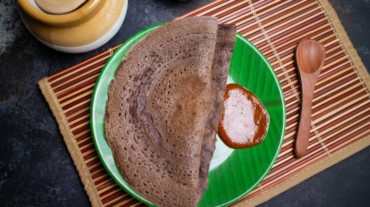[ad_1]
Diabetes has become a major concern in India, and there is a recent study to support this. Over 100 million Indians were found to have diabetes, according the Indian Council of Medical Research–India Diabetes (ICMR-INDIAB) study. Those with type 2 diabetes need to follow a strict diet. Ragi is considered to be the perfect choice for people living with diabetes due to its high fiber and mineral content.
Health Shots reached out to holistic health coach Azhar Ali Sayed to find out about ragi and diabetes.
Ragi is good for diabetes
The nutritious grain is also known as finger millet and it offers several health benefits, including its potential to help manage diabetes, says Sayed. Here are a few ways in which ragi can be beneficial for people living with diabetes:
1. Low glycemic index
Ragi has a low glycemic index (GI), which means it causes a slower and more gradual rise in blood sugar levels compared to high-GI foods. This can be beneficial for people with diabetes as it helps to prevent rapid spikes in blood sugar levels.
2. High fiber content
Ragi is rich in dietary fiber, particularly soluble fiber. It is something that plays a crucial role in diabetes management. It slows down the absorption of glucose, and this helps to prevent sudden rise in blood sugar levels.
3. Nutrient-dense
Ragi is packed with essential nutrients, including vitamins like B1, B3, and B6, minerals such as calcium, iron, and potassium, and antioxidants. These nutrients support overall health and might help to prevent or manage complications associated with diabetes.
3. Improved satiety
The high fiber content in ragi can help to increase feelings of fullness and promote satiety. By promoting satiety, ragi can assist in weight management. It is important for people living with diabetes as maintaining a healthy weight helps to control blood sugar levels.
4. Gluten-free alternative
Ragi is naturally gluten-free, making it a suitable grain option for people with celiac disease or gluten intolerance who also have diabetes, says Sayed.
Tips to include ragi in breakfast, lunch and dinner
Well, you can’t eat it in all your meals as excess consumption of ragi foods can increase the potassium levels in your body. It can cause problems like tingling sensations, nausea, and chest pain, says the expert. Also, ragi is digested slowly, so its excess consumption can cause severe constipation problems. You can choose whether to have ragi in the morning or later in the day or night.

1. Breakfast
Ragi Porridge
Sayed says you can cook ragi flour with water or milk to make a thick porridge. Add healthy sweeteners like honey or jaggery, along with chopped fruits or nuts for added flavour and texture.
Ragi idli or dosa
Replace a portion of rice with ragi flour while preparing idli or dosa batter. Ferment the batter overnight and make nutritious ragi idlis or dosas for breakfast.
Ragi pancakes
Combine ragi flour with other flours like wheat or oats, along with buttermilk, and prepare pancakes. Serve them with your favourite toppings such as fruits or yogurt.
2. Lunch
Ragi roti
Mix ragi flour with wheat flour, add spices, chopped vegetables, and knead it into a dough. Roll out the dough and cook it on a griddle to make healthy ragi rotis. Serve them with curries or yogurt.
Ragi upma
Prepare upma by roasting ragi flour and cooking it with vegetables, spices, and water. It makes for a wholesome and filling lunch option.
Ragi salad
Sprout ragi seeds and mix them with chopped vegetables, herbs, and a dressing of your choice. This refreshing salad can be a nutritious addition to your lunch.
3. Dinner
Ragi soup
Cook ragi flour with vegetable broth, chopped vegetables, and spices to make a hearty ragi soup. It can be a comforting and nourishing option for dinner.
Ragi pasta
Prepare ragi pasta by mixing ragi flour with wheat flour or all-purpose flour. Cook the pasta and toss it with your favourite sauce and vegetables.
Ragi khichdi
Combine ragi with rice, lentils, and vegetables to make a wholesome khichdi. Season it with spices and serve it with yogurt or pickle.
You can end your dinner with diabetes-friendly ragi and coconut laddus.
The expert says that the recommended daily intake of ragi or any other food for diabetics can vary. It all depends on factors like your overall health, medication, activity level, and your body’s response to different foods. So, it’s best not to go overboard with ragi!
[ad_2]
Source link

